#pit viper
Text

Lanna Green Pit Viper (Trimeresurus lanna), female, family Viperidae, Chiang Mai, northern Thailand
Venomous.
This species was recently split off from T. popeiorum, 2024.
photograph by Natthaphat Chotjuckdikul
627 notes
·
View notes
Text
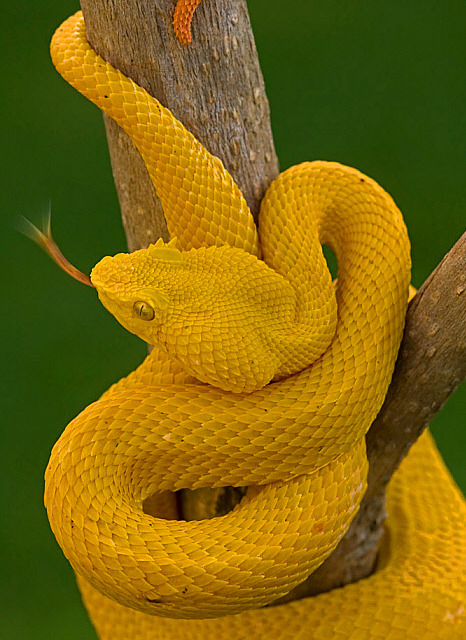
Eyelash Palm-pitviper (Bothriechis schlegeli)
Photo by John Cancalosi
#Bothriechis schlegeli#eyelash viper#Bothriechis#eyelash palm-pit viper#pit viper#viper#snakes#yellow#yellow snakes#reptiles#animals#wildlife#nature
186 notes
·
View notes
Text







been drawing too many old men recently, hi, im a lesbian, cute Gorgon girls be upon Ye
#traditional art#gorgon#ballpointpen#snakes#monster girl#yea im tagging all them snakes#spiny bush viper#coral snake#ball python#corn snake#black mamba#pit viper
65 notes
·
View notes
Text

Limestone jewel: A new colourful karst-dwelling pitviper (Serpentes: Viperidae: Trimeresurus) from the poorly explored borderlands of southern peninsular Thailand
Sabira S. Idiiatullina, Parinya Pawangkhanant, Tanapong Tawan, Thanawut Worranuch, Bunyarit Dechochai, Chatmongkon Suwannapoom, Tan Van Nguyen, Lawan Chanhome, Nikolay A. Poyarkov
Abstract
We describe a new species of pitvipers from Trang Province of Thailand, near the Thailand–Malaysian border, based on morphological and molecular (2427 bp from cyt b, ND4, and 16S rRNA mitochondrial DNA genes) lines of evidence...
The new species is currently known from a small karstic area in the Nakawan Range spanning the border of Thailand and Malaysia, in particular in limestone forests in Trang and Satun provinces (Thailand); it likely also occurs in the adjacent parts of Perlis State (Malaysia).
Our study also suggests that the taxonomy of T. kanburiensis species complex requires further studies; in particular our study suggests that the status of populations from Chumphon Province of Thailand and Pulau Langkawi Island of Malaysia should be re-assessed.
Read the paper here:
Limestone jewel: A new colourful karst-dwelling pitviper (Serpentes: Viperidae: Trimeresurus) from the poorly explored borderlands of southern peninsular Thailand (arphahub.com)
118 notes
·
View notes
Photo

Davina, 29
“My sunglasses are Pit Viper, bag is Coach, sweater is thrifted and shiny pants are a gift from one of my gay siblings, and shoes are Nike. What inspires my style is the intersection of cozy, glam, and a sprinkle of tacky. Never let them know your next move and pump the streets like a runway.”
Sep 24, 2022 ∙ Chinatown
#nyc looks#street snap#street style#street fashion#pit viper#coach bag#thrifted#style#looks#outfits#new york
366 notes
·
View notes
Text

(Trimeresurus albolabris) white-lipped pit viper
43 notes
·
View notes
Link
A substance found in fruits and vegetables can neutralize the venom of a poisonous pit viper common in much of South America, Brazilian researchers have discovered.
In Brazil, the Bothrops jararaca, also called "yarara," is responsible for most of the country's roughly 26,000 recorded snake bites each year, according to the online Reptile Database.
The study, conducted by Sao Paulo's Butantan Institute and published in the journal Frontiers in Pharmacology, found that a modified version of the compound rutin, the water soluble succinyl rutin, can delay the effect of a poisonous bite.
Continue Reading.
401 notes
·
View notes
Text
Animal of the Day!
Eastern Diamondback Rattlesnake (Crotalus adamanteus)
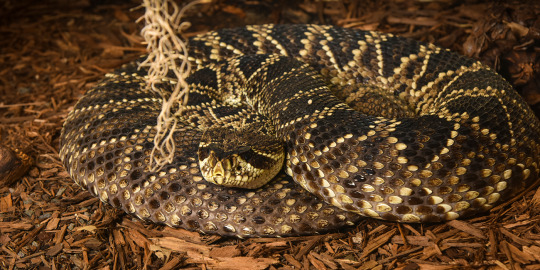
(Photo from Smithsonian’s National Zoo)
Conservation Status- Least Concern
Habitat- Eastern United States
Size (Weight/Length)- 6 kg; 1.5 m
Diet- Small mammals; Birds; Insects
Cool Facts- Being the largest and most venomous rattlesnake in North America, more people die from this snake than any other in the continent. Generally a slow moving hunter, the eastern diamondback rattlesnake basks on open rocks to warm up. After finding a bush or some leaflitter, the rattlesnake will ambush prey and bite it. The snake then follows the scent of the dying prey and swallow it whole after the animal dies. Being an excellent swimmer, eastern diamondback rattlesnakes can swim miles from land and towards oceanic islands in the Gulf of Mexico. Despite being highly venomous, rattlesnakes are often more afraid of you than you are of it. The snake uses its rattle to tell you to back off and it will only strike as a last resort. Best to watch your step and leave these guys alone.
Rating- 11/10 (You hear a rattle, you walk in the opposite direction.)
Animtober- Uh-Oh (Most dangerous snake in North America.)
#Animal of the day#Animals#Snakes#Rattlesnake#Pit viper#Saturday#October 29#Eastern diamondback rattlesnake#biology#science#conservation#the more you know#Animtober#Inktober#Uh-oh
161 notes
·
View notes
Text

Large-scaled Pit-viper
#large scaled pit viper#pit viper#snake#Craspedocephalus macrolepis#Trimerusurus macrolepis#Reptilia#Squamata#Serpentes#Viperidae#Craspedocephalus#upl
26 notes
·
View notes
Text
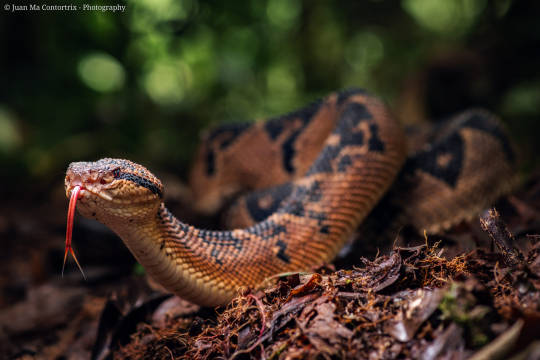
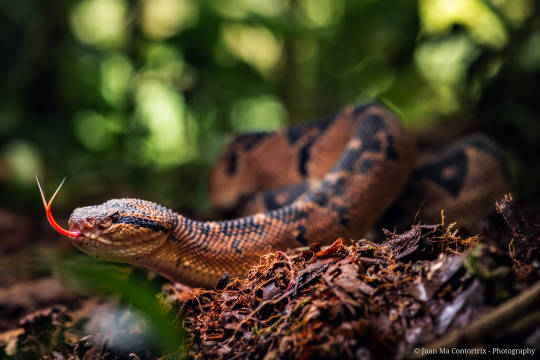
South American Bushmaster (Lachesis muta), family Viperidae, Amazonian Ecuador
Venomous.
This is a large snake, that can grow up to 10 feet in length, but 8 ft long is more common.
photograph by Juan Ma Contortrix
#bushmaster#lachesis#viperidae#pit viper#venomous#snake#reptile#herpetology#animals#nature#south america
457 notes
·
View notes
Text
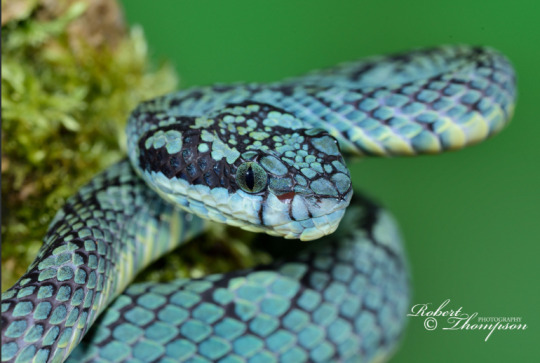
Sri Lankan pit viper (Trimeresurus trigonocephalus)
Photo by Robert Thompson
#sri lanka#ceylon#sri lankan pit viper#pit viper#viper#Trimeresurus trigonocephalus#Trimeresurus#pala polonga#snake#blue#blue snake#colorful snake#reptiles#animals#wildlife#snake portrait#snake photography#nature
24 notes
·
View notes
Text

Februarty #2! Shout out to @herpsandbirds for posting the best pictures I want to draw all these creatures!!
#februarty#art#artists on tumblr#drawing#original art#posca#posca art#snake#viper#pit viper#posca markers#reptile
12 notes
·
View notes
Text

an eyelash pit viper spotted on our first rainforest hike
#I was soooo excited he was so incredibly small. I can’t believe it’s been almost a year. this was December 31st 2022#eyelash pit viper#pit viper#snakes#reptiles#costa rica#squamata#reptilia#animalia#snake#upload#my photography
19 notes
·
View notes
Text

Malaysian pit viper
By: Jeff Foott
From: The Complete Encyclopedia of the Animal World
1980
#pit viper#viper#snake#reptile#1980#1980s#Jeff Foott#The Complete Encyclopedia of the Animal World (1980)
34 notes
·
View notes
Text
daily snake #8

💚 The Salazar’s Pit Viper (Trimeresurus salazar), first discovered in 2019, is a venomous green pit viper native to the lowlands of Arunachal Pradesh, India. It was named after Salazar Slytherin, from Harry Potter, and its habitat is currently under threat from human activity.
#snake#reptile#snakeblr#sciblr#biology#salazar's pit viper#pit viper#green pit viper#trimeresurus salazar#viper#zoology
12 notes
·
View notes